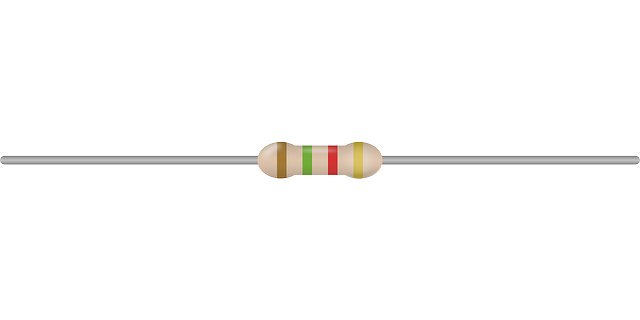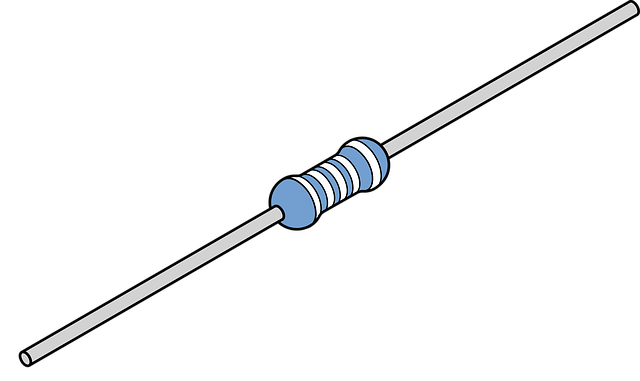Meta Description
Learn about the differences and uses of power resistors and normal resistors in electrical circuits. Understand the factors to consider when selecting a suitable resistor for your circuit.
Introduction
Power and normal resistors are used in electronic circuits to control the current and voltage flowing through the circuit. They are similar in many ways, but some key differences between the two types of resistors make them better suited for specific applications.
Power resistors are designed to handle high power and electrical energy levels, while normal resistors are typically used for lower-power applications. Power resistors are also typically larger and more expensive than normal resistors, and they have different ratings and specifications that make them better suited for certain applications.
We will investigate the similarities and differences between power resistors and normal resistors and explore how they are used in electronic circuits.
Power resistors
Power resistors are designed to handle high power levels, typically in the range of several watts to several hundred watts. They are typically larger than normal resistors and are constructed with materials that can withstand higher power levels.
Power resistors are made from ceramics, metal alloys, and graphite (high thermal conductivity). Power resistors, such as surge protection circuits, are also used in circuits where more power needs to be dissipated quickly.
Another characteristic of power resistors is their high resistance values. They are typically rated for between 1 and 10 ohms, which allows them to dissipate large amounts of power in a small space. This makes them ideal for use in circuits where space is at a premium.
Power resistors are also designed to handle high temperatures and are typically made from materials such as ceramics, metal alloys, and graphite. These materials have high thermal conductivity and can quickly dissipate heat, which is important in circuits requiring high power dissipation.

Applications of Power Resistors
Power Resistors are used in multiple applications, including:
1. Power Supplies
Power resistors are used in power supply circuits to regulate the voltage and current levels. They are typically used with other components, such as diodes and capacitors, to create a stable power supply circuit.
2. Motor Control
Power resistors are used in motor control circuits to control the speed and torque of motors. They are typically used with other components, such as transistors and diodes, to control current flow to the motor.
3. Industrial Control
Power resistors are used in industrial control circuits to control the operation of various types of equipment. They are typically used in conjunction with other components, such as relays and contactors, to control the power flow to the equipment.
4. Heating Elements
Power resistors are used as heating elements in various applications, such as ovens, heaters, and other heating devices. They are typically used in conjunction with other components, such as temperature sensors, to control the temperature of the heating element.
5. Inverters
Power resistors are used in inverters to dissipate excess energy and to control the current and voltage flowing through the inverter circuit. They are typically used in the output stage of the inverter to limit the maximum current and voltage output.
They can also match the impedance of the inverter to the load it is connected to, improving efficiency and stability.
Additionally, power resistors can be used in the input stage of the inverter to limit the amount of current flowing into the inverter, which can protect the inverter from damage caused by over-current conditions.
6. Motor Drives
Power resistors are used in motor drives for a variety of purposes.
- Dissipating energy during dynamic braking can increase the braking performance and reduce wear on the mechanical brakes.
- Limiting current to protect the motor from over-current conditions.
- Controlling the speed of the motor by adjusting the voltage applied to the motor.
- Protecting the motor from overvoltage conditions.
- Mitigating harmonic distortions in the power supply and improving the power quality.
- Providing damping in a drive system where the load or the motor itself can cause oscillations or vibrations.
- Improving power factor in the motor drive circuit by consuming the reactive power.
7. Surge protection circuits
Power resistors are used in surge protection circuits to dissipate the energy from transient voltage surges, which can protect sensitive electronic equipment from damage. They are typically combined with other components, such as varistors or gas discharge tubes, to form a surge protection circuit.
Power resistors can be used in series or parallel with the protected circuit to limit the current flowing through the circuit during a surge or divert it away from the circuit. They can also be combined with other components to provide both series and shunt protection to a circuit.
Power resistors also can be used as damping resistors to suppress high-frequency transients and reduce EMI/EMC emissions and in power factor correction circuits to consume the reactive power and improve the power factor.
Power resistors in surge protection circuits are typically rated to handle high power and energy levels, with high surge currents, peak power ratings, and high thermal dissipation capabilities.

Normal resistors
Normal resistors, also known as low-power resistors, are designed to handle lower power levels, typically in the range of a few milliwatts to a few watts. Normal Resistors are made from materials such as carbon film, metal film, and wire wound (lower thermal conductivity)
They are commonly used in circuits such as amplifiers, filters, and voltage dividers. Normal resistors are also used in circuits where a precise resistance value is required, such as in precision measurement circuits.
One of the main characteristics of normal resistors is their low power rating. They are typically rated for between 1/8 and 1 watt and can handle much lower currents than power resistors. This makes them ideal for use in circuits with low power dissipation.
Another characteristic of normal resistors is their low resistance values. They are typically rated for between 1 and 10 ohms, which allows them to dissipate small amounts of power in a large space. This makes them ideal for use in circuits where space is not a concern.
Normal resistors are also designed to handle lower temperatures and are typically made from carbon film, metal film, and wire-wound. These materials have lower thermal conductivity and can dissipate heat slowly, which is important in circuits where low power dissipation is required.
They are typically smaller than power resistors and are constructed with materials that can withstand lower power levels.
Applications of Normal Resistors
Normal Resistors are used in a variety of applications, including:
1. Signal Processing
Normal resistors are used in signal processing circuits to filter, amplify, and shape electronic signals. They are typically used with other components, such as capacitors and transistors, to create signal-processing circuits.
2. Digital Logic
Normal resistors are used in digital logic circuits to create various logic gates. They are typically used with other components, such as transistors and diodes, to create digital logic circuits.
3. Sensors
Normal resistors are used in sensor circuits to detect changes in various physical parameters, such as temperature, pressure, and light. They are typically used with other components, such as transistors and diodes, to create sensor circuits.
4. Measurement
Normal resistors are used in measurement circuits to measure various electrical parameters, such as voltage, current, and resistance. They are typically used with other components, such as ammeters and voltmeters, to create measurement circuits.
5. Amplifiers
Normal resistors, also known as fixed resistors, are widely used in amplifiers to control the current and voltage flowing through the amplifier circuit. Normal resistors can be used to set the DC operating point of the transistor or other active devices in the amplifier circuit.
They can be used for various purposes, such as setting the DC operating point of the active devices in the amplifier circuit, providing negative feedback for better stability and linearity, impedance matching, voltage division, current limiting, damping, and power factor correction.
The resistor’s value in the amplifier circuit depends on the application’s specific circuit design and requirements.
6. Filters
Normal resistors are commonly used in filter circuits to control the current and voltage flowing through the circuit and improve the filter’s performance. They can be used for impedance matching, signal attenuation, damping, filter design, and power factor correction.
Impedance matching improves the power transfer and reduces distortion; signal attenuation helps to reduce the input voltage to a suitable level. Damping resistors suppress high-frequency transients and reduce EMI/EMC emissions.
Filter design with other passive components like capacitors and inductors allows the designing of different filters like low pass, band pass, high pass, and band stop filters. Power factor correction helps improve the power factor.
The specific values of resistors used in the filter circuit depend on the circuit design and the application’s requirements.
7. Voltage Divider
Normal resistors are used in voltage dividers to reduce the input voltage to a level suitable for the connected circuit. They are combined with other variable resistors in a voltage divider circuit where the input voltage is divided, resulting in lower voltage output.
Voltage dividers are commonly used in measuring, sensing, and adjusting voltage levels. These resistors are combined with other passive components like capacitors, inductors, and diodes to design different voltage dividers.
They can be used in circuits like power supplies, amplifiers, and measurement devices to adjust the voltage to the desired level. The specific values of resistors used in the voltage divider circuit depend on the circuit design and the application’s requirements.
8. Precision measurement circuits
Normal Resistors are an essential component in precision measurement circuits, providing a stable and known resistance for the circuit to measure against. They can be used in voltage dividers, current sensing, impedance matching, reference resistors, and null detection, all of which are important aspects of precision measurement.
The resistors used in these circuits are typically precision resistors with a higher tolerance and stability than standard resistors.
Designing and Building circuits
When selecting resistors for a particular application, it is important to consider factors such as power rating, resistance value, and temperature rating. Doing so ensures that you are using the right resistor for the job and that your circuit will function as intended.
The selection of the right resistor is crucial for the efficiency of the circuit; thus, always consider the power rating, resistance value, and temperature rating when selecting resistors for a particular application.
Making the suitable choice for your circuit
When it comes to power resistors, they are most commonly used in power-related applications such as power supplies, inverters, and motor drives. These applications require high power dissipation and high current loads, and high power resistors can handle these conditions due to their high power rating and high resistance values. Power resistors are also typically made from ceramics, metal alloys, and graphite, which have high thermal conductivity and can dissipate heat quickly.
On the other hand, normal resistors are most commonly used in signal-related applications such as amplifiers, filters, and voltage dividers. These applications require precise resistance values and low power dissipation ratings, and normal resistors can provide these conditions due to their low power rating and low resistance values.
Normal resistors are also typically made from carbon film, metal film, and wire wound, which have lower thermal conductivity and can dissipate heat slowly.
Tolerance of the Resistor
When selecting resistors for a particular application, several factors must be considered. In addition to power rating, resistance value, and temperature rating, it is important to consider the resistor’s tolerance.
Tolerance refers to the accuracy of the resistance value and is usually specified as a percentage. For example, a variable resistor with a tolerance of 5% means that the actual resistance value can be as much as 5% different from the nominal value.
Type of Circuit
Another important consideration when selecting resistors is the type of circuit in which the resistor will be used.
For example, if the circuit is exposed to high voltage or high frequency, it is important to choose a resistor specifically designed for these conditions.
Some resistors, such as wire-wound resistors, are better suited for high-frequency applications, while others, such as metal film resistors, are better suited for high-voltage applications.
Form Factor of the Resistor
In addition to the factors mentioned above, it is also important to consider the form factor of the resistor. Resistors come in various form factors, including axial, radial, and SMD (Surface Mount Device).
Axial resistors are the most common type and are typically used in circuits where space is not a concern. Radial resistors are typically smaller in size and are used in circuits where space is at a premium. SMD resistors are even smaller and commonly used in surface mount circuits.

Other Options
It is also essential to note that other types of resistors, such as precision resistors, wire-wound resistors, surface mount resistors, and non-inductive resistors, have unique characteristics and uses. For example,
- Precision resistors are used in applications where a very precise resistor value is required, such as in precision measurement circuits.
- Wirewound resistors are used in high-power and high-frequency applications because they handle high currents and temperatures.
- Non-inductive resistors are used in circuits where the inductive effect of the resistor values must be minimized, such as in radio frequency circuits.
Conclusion
In conclusion, power resistors and normal resistors are both essential components in electrical circuits, but they serve different purposes and properties. Understanding the characteristics and uses of these two types of resistors is crucial for designing and building circuits that meet your requirements.
